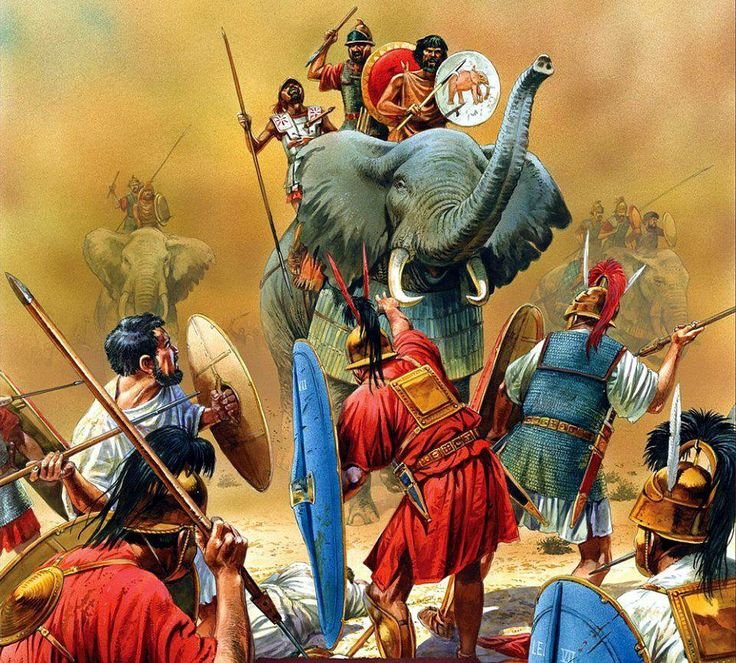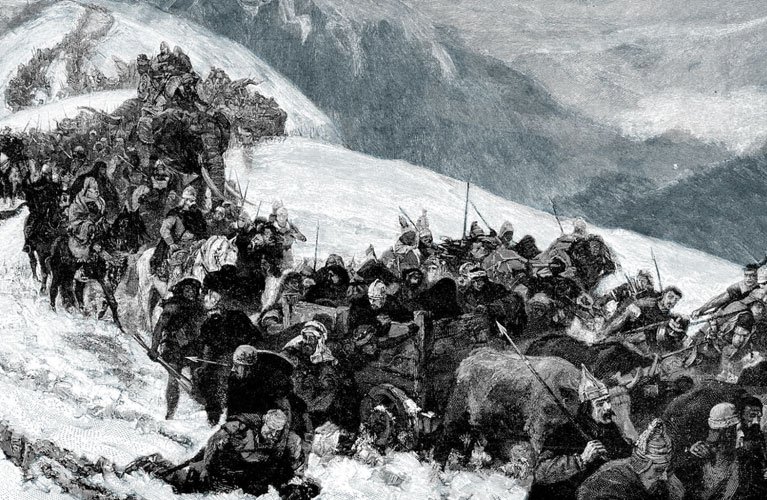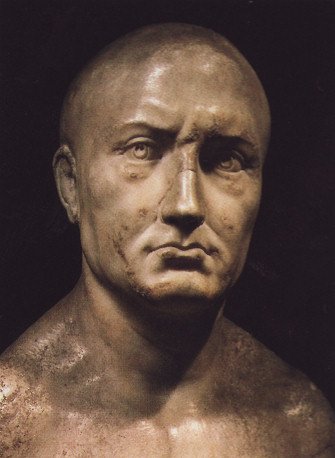In 241 B.C. Rome "wins" the first Punic War. I say it in quotes because Rome suffered great casualties at sea when all they needed to do in the end was capture an entire Carthaginian merchant fleet. However they do absorb Sicily, Corsica, and Sardinia as a result, so all was not in vain. These are the roots of the empire - geographically, not the political system itself. Carthage at this point now wants to make an example out of Rome.

Carthage is now building a terrifying army of mercenaries in Spain, led by Hamilcar Barca. He gathers 100,000 men in his army, including his own children who he raises in it. Hamilcar doesn't just have the numbers however, he uses his men to expand the empire further into Spain. When he died, he had already groomed his successor - his own son Hannibal Barca. Since Hannibal was raised in the army, he was a great tactician and commander. These soldiers were training and fighting everyday, while the Romans were busy farming most of the time.
Saguntum
Rome was so concerned with what was happening, that they struck an alliance with Saguntum, a small town in Spain. Saguntum becomes a window into looking out and watching Hannibal's army. Well, Saguntum begins to get a bit arrogant and starts taunting Hannibal - since they're aligned with Rome, they believe he won't do anything for fear of being defeated again. By doing this though, they are trying to convince other city-states under his control to rise up. The Romans didn't really understand Hannibal unfortunately.
In 218 B.C. Hannibal sieges and eventually seizes Saguntum. Rome realizes they can't take them on, so they try diplomacy instead. Representatives were sent to the Carthaginian senate, asking them to make things right. They first ask for the restoration of Saguntum, then they want Hannibal punished - in actuality they want him to be turned over to Rome to be killed. Carthage simply refuses and Rome is left with no time to decide what to do.
Hannibal is so furious, he takes 59,000 men and 50 elephants and marches towards Rome. He doesn't take his entire army of 100,000 because he would lose control of Spain. It took him five months to get from Spain to the Alps. Unfortunately, he left in the summer and arrived to this mountain chain in the winter, and it took him 15 harrowing days to travel through. Many people froze to death, while others and many elephants lost their footing and slipped off cliffs. On top of that the barbaric Gauls were settled there. Up on high cliffs the Gauls would shoot arrows down at them while they passed through the valleys. Once they reached the other side, they were left with only 24,000 men and most elephants dead.

Fabius
In Rome, the Consuls elected and the Senate approved of a dictator. Quintus Fabius Maximus Verrucosus was elected and he only had 6 months, or until the crisis was dealt with, as dictator. He says Rome can not defeat Hannibal so he decides to use his own strategy against them. Fabius performs what could be considered today as "guerrilla warfare". His soldiers follow Hannibal, kill off stragglers, disrupt supply lines and, once they learned of what town they were heading to, would request the citizens to burn their crops.

Once Hannibal figures out what's going on, he burns the villas around Fabius' own to make it seem as though he's working with the Carthaginians. Many Romans were furious at this point; some buy into this scheme, while others just want to actually fight, not wait around and follow Hannibal. They came up with some interesting nicknames like "Fabius the Delayer" or "Hannibal's Pedagogus, a slave who would carry a child's schoolbooks. The Senate chooses not to renew his dictatorship and instead decide that both Consuls, Varro and Pallus, are going to lead the armies. They combine their forces making up 86,000 total men. They even included volunteers and one-third of the senate joining forces. Before they left they made an oath; win or die. It was made illegal for soldiers to return home if they didn't win.
Cannae
Battle took place here in southern Italy on August 2, 216 B.C. Hannibal arrived with only 24,000 men but now the number jumped up to 47,000 by using defeated people like the Gauls and shipping in Libyans and Spaniards. In just a couple hours however, Rome suffers its biggest defeat. Although the Consuls began with 86,000 soldiers, Hannibal took 10,000 hostage while 10,000 more don't end up in the battle at all. All 66,000 left were killed.
Command of the Roman army alternated between the two consuls, it was against the rules of the Republic to control such a huge army. Hannibal enlists spies to learn the differences between Varro and Pallus. He figures out that Pallus is more reluctant to fight and more cautious, while Varro is hotheaded and wants to fight immediately. When it's Pallus' day to command, Hannibal cuts the water supply to the Romans. On Varro's day, Hannibal provokes him. He takes the bait and attacks before the men had breakfast. They were now fighting in the dead of summer without having had food or water.
The Romans think they're going to push the enemy with overwhelming numbers down to a nearby river. They come into battle in a giant phalanx. They successfully push but the center of the line does not break. Hannibal's line is bending, wrapping around the Romans. They used smaller phalanxes which made it more flexible. Plus there was dust kicking up which kept them from seeing an African infantry coming in. This dust also prevented those 10,000 soldiers from realizing the fight even began.

Within hours of the battle starting, all of the officers were dead, including Pallus, with the exception of Varro who manages to escape. No one was left to surrender. Romans weren't even fighting by the end, they were being butchered and senators were forced to fight as gladiators. The surviving 10,000 men were exiled to Sicily with no equipment due to the oath that was taken.
Why did they lose?
This horrible loss caused Romans to believe they did something to offend the Gods. They end up finding two vestal virgins who were in fact not virgin; one was allowed to commit suicide while the other was buried alive. They even turned to human sacrifices, which was rare for Romans. One problem we can be certain of was the huge phalanx that was used. It allowed the legions to be surrounded by Hannibal's much smaller and flexible phalanxes. Another was Hannibal's knowledge of the differences between the two Consuls and used it against them.
Rome is in utter panic after Cannae and is left with only the young and old. The draft age was lowered and free slaves were allowed to enlist in order to accommodate. Another thing that aided Hannibal were the Greeks in the southern colonies that provided resources; Rome eventually punished those for betraying. After his victory, Hannibal wanders and roams around Italy from 216 to 204 B.C. This angers the Romans, there's nothing they can do as he travels from town to town and leaving nearly nothing behind.

Scipio Africanus
One person comes forward with a plan. Scipio was too young for military command, although his father commanded troops in Spain until he died. He appears in front of the Senate to tell them they must break Carthage's Spanish empire. His reasoning being that if it's broken enough and conquered, Hannibal won't get what he needs. Without silver or grain, he wouldn't be able to stay in Italy without the support.
Scipio ends up having to bribe to get the privilege to command since he was too young. In 206 B.C. he is granted an army and goes to Spain and is overwhelmingly successful. He breaks up the empire and absorbs enough of Spain that Spain is no longer able to afford any aide to Hannibal. Scipio returns home with 14,342 pounds of silver and gives it all to the treasury. However this is still not the end for Carthage.

Source: Alchetron
The first image really reminds of the The Lord of the Rings with the giant elephant-like creatures. Probably inspired by that.
Woah, it actually does look like that!
great story
It made a very interesting read for me. Hope you will continue this soon
Thank you! I do plan on doing the third and final one soon!